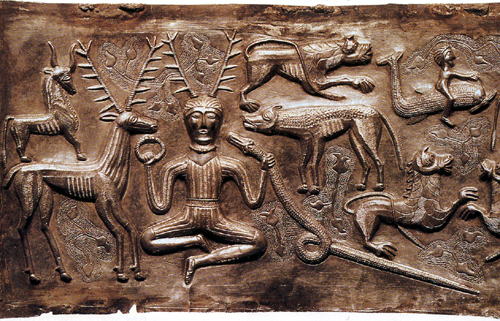|
Roman Silverware One of the most beautiful forms of Roman art is silverware - plates, bowls, and other objects made of silver, with pictures formed in the silver. The artists used a technique we now call 'repoussť', from a French word meaning to push. The silver was 'pushed' out using special tools, metal objects with rounded ends which were hammered into the silver. This method was used with other metals too, like gold and bronze. The Celts created art using repoussť too (see the bottom of this page). The Mildenhall Treasure The most famous silverware in Britain is called the Mildenhall Treasure. This was found in a field in Mildenhall, Suffolk, in 1942. The finders did not realise the importance of what they had for several years, and then in 1946 the treasure was acquired by the British Museum, where you can see it today. There are 34 pieces of treasure in all, including plates, bowls, ladles, and spoons. The most famous piece is the great dish, which you can see in the picture to the right (click to see a big version). It shows mythical characters like the god Bacchus and Pan (with the goat's legs), as well as some ladies worshipping Bacchus (see below). In the middle is the sea god Oceanus. The Mildenhall Treasure dates from the late 300s (towards the end of Roman rule in Britain, when most Romans were Christian). It was probably made in North Africa or somewhere else on the Mediterranean. On this page you can see other items from the Mildenhall Treasure and some other Roman silverware. Mildenhall Museum At Mildenhall itself there is a museum which has replicas of all the items in the treasure. It has lots of other objects of interest too, including the skeleton of an Anglo-Saxon warrior and his horse with its bridle jewellery.
Detail from the Mildenhall Great Dish
|
Great dish from the Mildenhall Treasure
Detail from the Mildenhall Great Dish |
|
Small plate from Mildenhall treasure |
Small plate from Mildenhall treasure |
|
Spoons from Mildenhall treasure |
Fluted bowl from Mildenhall treasure
Covered bowl from Mildenhall treasure
|
|
The Corbridge lanx - silver tray found at Corbridge, near Hadrian's Wall, in 1735. It shows several Roman/Greek gods (Diana, Minerva, and Apollo) at the shrine of Apollo in Delos, Greece.
|
Beautiful silver vase found at Hildesheim, Germany
|
 Bowl showing the goddess Roma, the patron god of Rome. |
Celtic silver plate, made with repoussť method. The man with stag's antlers is the Celtic god Cernunnos. He has a snake in one hand and a torc in the other. What is the difference in style between Roman and Celtic silverware? |










